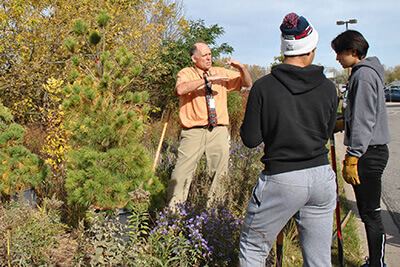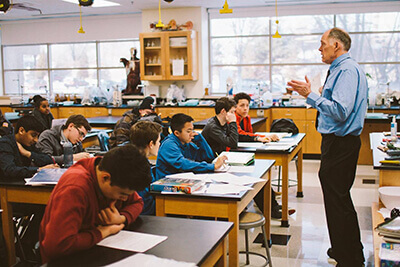April 19, 2023
 When and how did you first come to MPA?
When and how did you first come to MPA?
August 1991. I had moved back to Minnesota in 1989, got married and taught for a year at St. Bernard’s school in St. Paul. I wanted to make a change and interviewed at MPA and St. Thomas Academy. I was offered a job at both schools. I really liked the atmosphere at MPA, knew Chris Jensen, and felt that MPA was the best place for me.
What memories do you have of your first days at MPA?
The joyful return of the students at Back to School Night. Camille Wainwright doing interesting demos in chemistry. Chris Jensen keeping the biology classes moving. I remember feeling that I was in a “fast” crowd. Here, at MPA, all the faculty were very talented and hard-working. The goal is creative, student-involved education and everyone, everywhere was doing this. The school was alive with positive action. I felt I needed to “raise my game” if I was going to be an effective part of this hard-charging group. There was such a collegial feeling between all the teachers. The male teachers had to wear a shirt and tie. This is where I started my biology tie collection. Mostly I was quiet and I listened. There was a lot to learn.
What’s the best thing about being a teacher at MPA?
I have the freedom to do what is best for my students. I can explore new ideas with colleagues and come up with interesting things for myself and the students to do. I can bring in new best practices and keep my classes current with what is happening in the world now. I can use the garden area as an ongoing research resource. I have connections with Ramsey Washington Metro Water Shed District and their expertise and support has been critical to the success of the rainwater gardens at school. I have the support of the administration and they have been instrumental in encouraging me to be involved in the garden, new classes, and new technologies. I have a wonderful relationship with my fellow science teachers. Every day is like a department meeting as we talk and share new ideas, and activities in a very collegial setting. We work together well as a team and we support and help each other.
Describe your typical day.
I like to get to school early. I am usually at school by 7 AM. I can open the room and take care of the plants and creatures that are there. I get a chance to think about my day, set my classes up, make sure I have copies ready, and that I have materials and supplies ready as well. I like to be in the hall and greet people as they come in. I think of the block as being divided into four parts. I like to have a good intro, then check on any ongoing experiments or show a video on a concept we are learning. Then it is time to work on the main activity or lab for that day. Often we have an ongoing lab along with a shorter one to work on. Discuss the study guide with help from the PowerPoint and then wrap the block up with what to do for our next meeting. Each class flows in a similar matter. I like to exercise and walk during the second block. So, I will hit the weight room and do laps inside the school. Since my knee replacement, I have found that it is good for me to work on getting that leg stronger. If it is a busy quarter, I will often eat lunch in the science office so I can keep working. The other science faculty are there and we can talk about the day, activities, etc. I usually stay after school for a while getting things ready for the next day. Sometimes students are with me retaking an exam or taking an exam that they missed.
Do you have a favorite lesson to teach?
I have a lot of favorites! One of my favorite activities is Pond Water Organisms. We start the year with this activity. Using microscopes, the students examine three general types of protists. I usually choose Stentor, Ameba, and Volvox. These three are very different from each other and for students who have not seen protists before they are impressive. After that, they bring in pond water from sources near them and we use our pond as a source of pond water organisms. Using pond water guides the students are tasked with locating and drawing at least three other pond water organisms, identifying it, and reporting on how they reproduce, get energy, and behave. This is a fun lab as you can see so many strange creatures, some relatively large and some with very unusual and interesting shapes. They love doing this lab and many will exclaim aloud when they find something they believe is really noteworthy. We spend three days on this investigation and it always seems we could spend more time exploring.
 What do your students teach you?
What do your students teach you?
During my career, I am impressed by characteristics of students that have not changed that much in 46 years. Names matter, students want you to know their names and to spell that name correctly. Learning is personal and is affected by all the things that are happening in their lives. It is important that they are challenged and yet it is important that there is some fun. Students need a chance to be doing science, they need to work with their hands. All of them want to do well, but many aren’t sure how that can be done. Students can be easily bruised, but are amazingly resilient when given the right support. The future, for most, is this vast unknown that is exciting and scary at the same time. All the interactions I have with students help to teach me who they are, what they are thinking, and what they need to be effective learners. They help me stay curious, be creative, be patient, keep trying, look for the best in everyone, and never stop dreaming.
How does MPA inspire students who dream big and do right?
MPA provides students with a liberal arts education that is collaborative, challenging and broad-based. All teachers at this school are involved in discussing issues of the times, of the past, and how things have changed and may change in the future. Through classes, clubs, and activities students are encouraged to broaden their interests, challenge their assumptions and realize that they have a role to play in how our society evolves. They come to realize the importance of an educated populace through many of the activities they become involved with (bumblebee studies, native plant growing and planting, pond water analysis, and bird and tree identification). They come to realize the importance and reliance that is placed on the citizen scientist and the positive effect that even small tasks can have. Many people doing a little can accomplish a lot.
If you have worked at another school, how has your experience at MPA been different?
The big differences at MPA have been the quality and commitment of the faculty and staff and the quality and commitment of the student body. It is an exciting and wonderful place to work. Nowhere else would I have had the same opportunities as I have had here. The school is full of people who dream big and do right every day.
What are you currently reading?
I am reading a book “Mustang Designer: The Story of Edgar Schmued.” This book traces the life and involvement of Edgar Schmued in the design and development of the P-51 Mustang in WWII. It is an amazing story of a person who became enthralled in aviation at a very young age, was encouraged by his father, and managed through his own hard work to become the chief designer of the plane that would be the best fighter of the war. It is an amazing story of perseverance, resilience, hard work, and luck.
What advice do you have for MPA alumni?
Stay curious and keep learning! Enjoy the going and be resilient. Get involved and do whatever you can to help. Even small actions have an impact. Stay positive and be enthusiastic.
Complete any or all of these sentences:
The MPA community inspires me to: try my best, be curious, be creative, and live a full life.
One thing I want my students to know: is how much I care for them and how much I want to help them.
Is there anything else you’d like to share about your MPA experience?
It has been an amazing place for me. I have taught middle school math and science, Anatomy, Astronomy, Physical Science, AP Biology, and Biology. All the subjects I have taught have enriched my Biology curriculum and made me a better Biology teacher. It demonstrates to me the value of a broad-based education and how that learning has enriched my own life and my understanding of the world we live in.